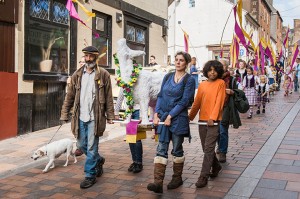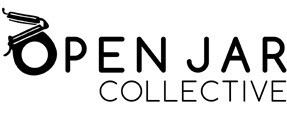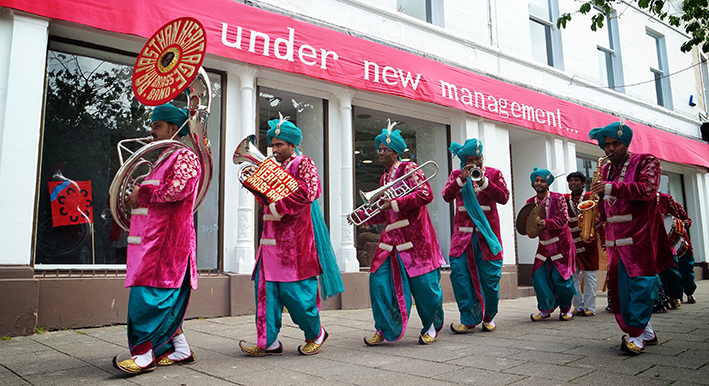From Mark Zygadlo

Vacca! The strange case of the lost locative. The Cow, subject and object as symbol. After Bonum, and Beckett (ablative, or is it genitive?)
Vacca, (the)Cow nominative,
Vacca, Oh, Cow, vocative,
Vaccam, you cow, accusative,
Vaccae, of (the)cow, genitive,
Vaccae, to or for (the)cow, dative,
Vacca, by, with, from, or in (the) cow, ablative
Remember that? Of course, it would have been Mensa, table, when we of a certain generation of the modern era were learning the first declensions; female gender singular. The Latin primer, being an expression of the late classical form, omitted the locative case of colloquial or early Latin. Ah, that hushed and subtle tongue.
Oh, the locative, (vocative case, denoted by Oh… as in: Oh, Caesar… or an exclamation mark, as in: Christ! Look at the time…) the locative! It must not be forgotten for it describes the rightness of place and the infinite distance of one location from another. It was reserved for speaking of small islands alone in the Mediterranean; no archipelagoes here, no chains of thought, no Peloponnese or Balearics, no reefs, no connections to the mainland by causeways impassable at high tide, or bridges or small ferry boats. No, and no barren rocks.
The locative speaks of being separate, of being appropriately self-contained, and it can refer to being in the earth, to death and burial, that is, to humiliation. Or, to being at home, at the hearth, focum, foc, and being in the field or fields, when that had some meaning. Specific, you see, to a state of being in place, self-sufficient, separate, discrete. If they had thought of it then, on line, on the net, would be a perfect locative; in a state of separateness described by the place—the net.
Being in a State of Grace? The Cow’s case: (genitive surely; the case of the Salted Cow, but…) Our cow’s argument is locative.
Oh, Locative, (vocative) You obsolete case; you last fragile threads of pre-classical illumination, Be exhumed in this ritual
And roar your bovine craving at us for the case we are losing from the locative field. But, pitiless grammar will not bring the bull. You shall die fallow, unfertilized In the shallows.
Cleave then, oh beast, With your split hoof and state your case, Standing up to your classical canons in it. After all, This is the sharp season of your atomized shit. Homunculus eyes focus on a darker green field. Yes, pump it out, boys. More shit, more grass, more beef, more milk, more shit, more grass, More gas, yes. More, more, more. That is our locus, our focum vivendi, our domicile, And we are such classical agrarians. It is the locative case of Shit.
Cow! (Vocative) You are sacrificial, you see? To the modus, (modo, to or for the way, dative case) to the modus, While the grammar of thought, the rules of understanding Are wiping this island from the charts. But some pre-classical urge, some visceral memory knows An identical ritual killing takes me too. Letting go so much for the sake of so it is a sacrifice alright, And we, in our improved datives, are sensible of thy gift, oh Cow, And preserve thee, black and leathery, from a hook somewhere We can no longer quite describe.
Salt beef, my life. Oh, holy shit.
Salt beef at Blum’s on the Whitechapel Road, And the long walk home through the pre-classical period When we were emergent, Or what passed for young, and understood where we were. But Blum’s, oh my dears, is gone. It was, not is And in its place, I leave my dybbuk. For we too are ephemera, Singing our hearts out In the locative case.
Nithraid was conceived as a public artwork to activate the riverside in Dumfries during the summer of 2013, bringing new focus and drawing people down to celebrate the River Nith. Now in its third year, Dumfries is preparing to welcome sailors upriver to the heart of the town as Nithraid 2015 sails into town on Sunday, 2nd August. Nithraid is free and open to all, and last year saw crowds of 4,000 lining the banks to watch the winning boats cross the finish line. Find out more about this year’s Nithraid here.
The discussion is open, and we invite contributions to our artistic conversations. Whether you have been involved in Nithraid in previous years, are interested in the changing face of public art, or are curious about how a sailing race can also be an artwork, please get in touch via the comments box below. Alternatively, to send your contribution, please email [email protected].

























